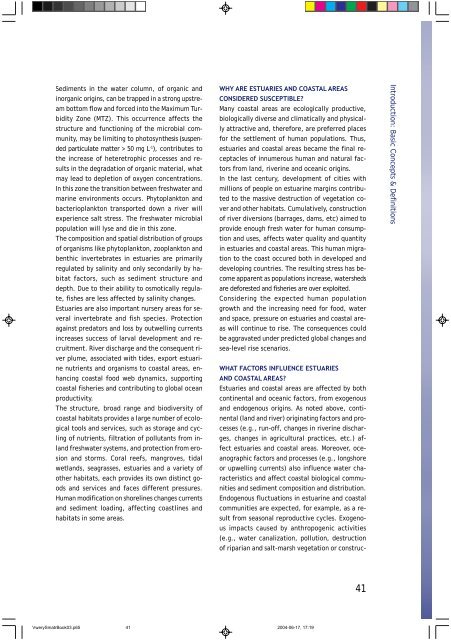Manual - International Environmental Technology Centre
Manual - International Environmental Technology Centre
Manual - International Environmental Technology Centre
You also want an ePaper? Increase the reach of your titles
YUMPU automatically turns print PDFs into web optimized ePapers that Google loves.
Sediments in the water column, of organic and<br />
inorganic origins, can be trapped in a strong upstream<br />
bottom flow and forced into the Maximum Turbidity<br />
Zone (MTZ). This occurrence affects the<br />
structure and functioning of the microbial community,<br />
may be limiting to photosynthesis (suspended<br />
particulate matter > 50 mg L-1 ), contributes to<br />
the increase of heteretrophic processes and results<br />
in the degradation of organic material, what<br />
may lead to depletion of oxygen concentrations.<br />
In this zone the transition between freshwater and<br />
marine environments occurs. Phytoplankton and<br />
bacterioplankton transported down a river will<br />
experience salt stress. The freshwater microbial<br />
population will lyse and die in this zone.<br />
The composition and spatial distribution of groups<br />
of organisms like phytoplankton, zooplankton and<br />
benthic invertebrates in estuaries are primarily<br />
regulated by salinity and only secondarily by habitat<br />
factors, such as sediment structure and<br />
depth. Due to their ability to osmotically regulate,<br />
fishes are less affected by salinity changes.<br />
Estuaries are also important nursery areas for several<br />
invertebrate and fish species. Protection<br />
against predators and loss by outwelling currents<br />
increases success of larval development and recruitment.<br />
River discharge and the consequent river<br />
plume, associated with tides, export estuarine<br />
nutrients and organisms to coastal areas, enhancing<br />
coastal food web dynamics, supporting<br />
coastal fisheries and contributing to global ocean<br />
productivity.<br />
The structure, broad range and biodiversity of<br />
coastal habitats provides a large number of ecological<br />
tools and services, such as storage and cycling<br />
of nutrients, filtration of pollutants from inland<br />
freshwater systems, and protection from erosion<br />
and storms. Coral reefs, mangroves, tidal<br />
wetlands, seagrasses, estuaries and a variety of<br />
other habitats, each provides its own distinct goods<br />
and services and faces different pressures.<br />
Human modification on shorelines changes currents<br />
and sediment loading, affecting coastlines and<br />
habitats in some areas.<br />
WHY ARE ESTUARIES AND COASTAL AREAS<br />
CONSIDERED SUSCEPTIBLE?<br />
Many coastal areas are ecologically productive,<br />
biologically diverse and climatically and physically<br />
attractive and, therefore, are preferred places<br />
for the settlement of human populations. Thus,<br />
estuaries and coastal areas became the final receptacles<br />
of innumerous human and natural factors<br />
from land, riverine and oceanic origins.<br />
In the last century, development of cities with<br />
millions of people on estuarine margins contributed<br />
to the massive destruction of vegetation cover<br />
and other habitats. Cumulatively, construction<br />
of river diversions (barrages, dams, etc) aimed to<br />
provide enough fresh water for human consumption<br />
and uses, affects water quality and quantity<br />
in estuaries and coastal areas. This human migration<br />
to the coast occured both in developed and<br />
developing countries. The resulting stress has become<br />
apparent as populations increase, watersheds<br />
are deforested and fisheries are over exploited.<br />
Considering the expected human population<br />
growth and the increasing need for food, water<br />
and space, pressure on estuaries and coastal areas<br />
will continue to rise. The consequences could<br />
be aggravated under predicted global changes and<br />
sea-level rise scenarios.<br />
WHAT FACTORS INFLUENCE ESTUARIES<br />
AND COASTAL AREAS?<br />
Estuaries and coastal areas are affected by both<br />
continental and oceanic factors, from exogenous<br />
and endogenous origins. As noted above, continental<br />
(land and river) originating factors and processes<br />
(e.g., run-off, changes in riverine discharges,<br />
changes in agricultural practices, etc.) affect<br />
estuaries and coastal areas. Moreover, oceanographic<br />
factors and processes (e.g., longshore<br />
or upwelling currents) also influence water characteristics<br />
and affect coastal biological communities<br />
and sediment composition and distribution.<br />
Endogenous fluctuations in estuarine and coastal<br />
communities are expected, for example, as a result<br />
from seasonal reproductive cycles. Exogenous<br />
impacts caused by anthropogenic activities<br />
(e.g., water canalization, pollution, destruction<br />
of riparian and salt-marsh vegetation or construc-<br />
VwerySmatrBook03.p65 41<br />
2004-06-17, 17:19<br />
41<br />
Introduction: Basic Concepts & Definitions

















